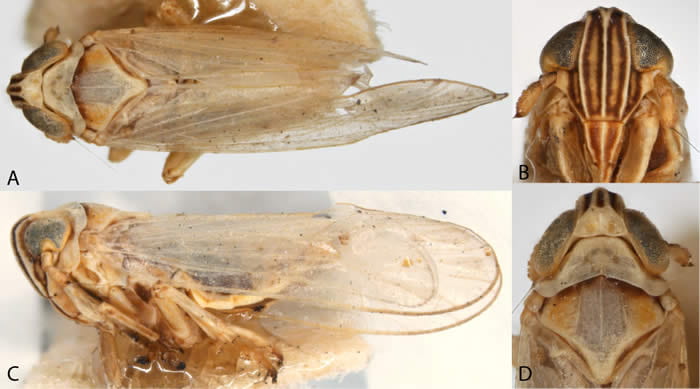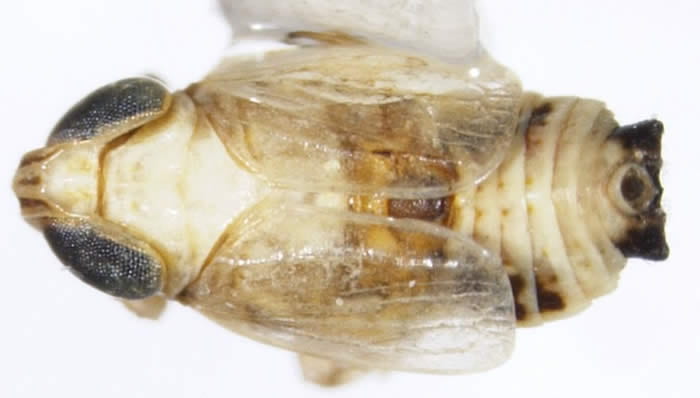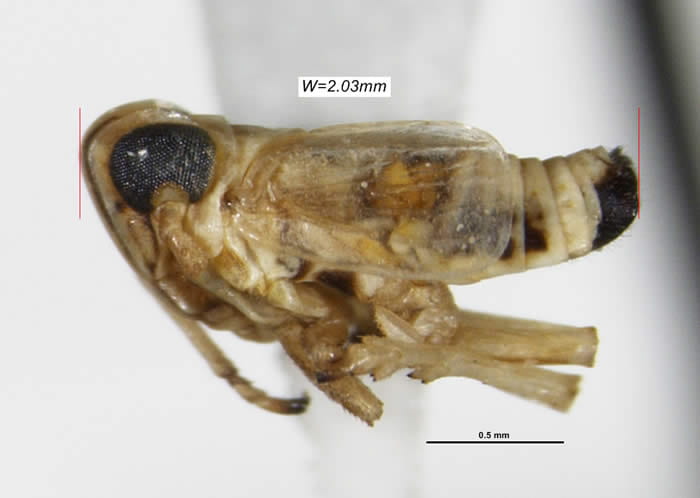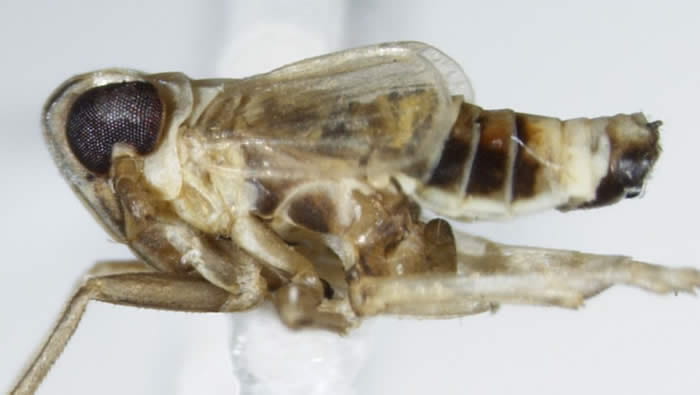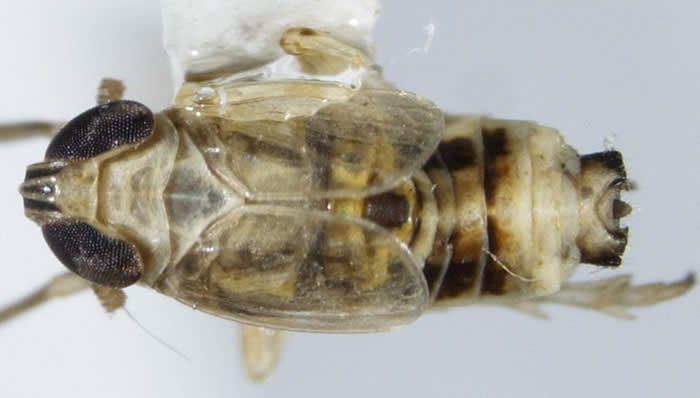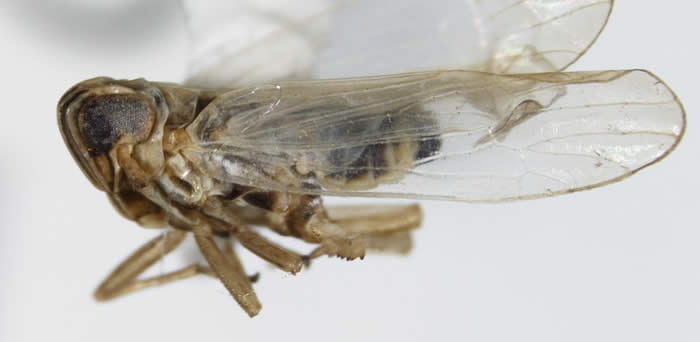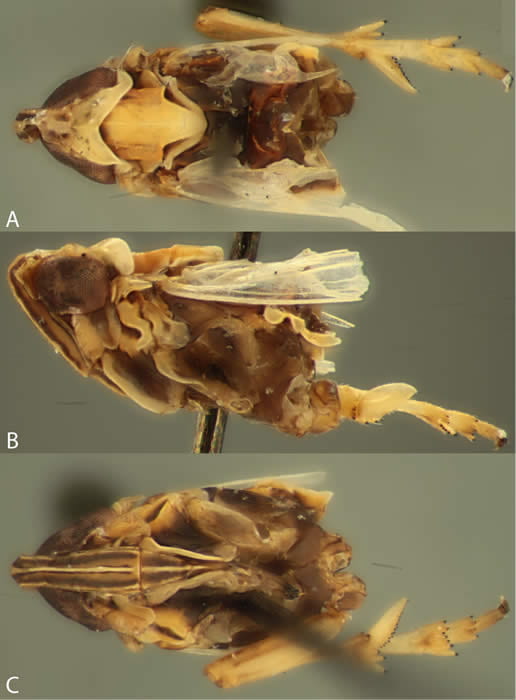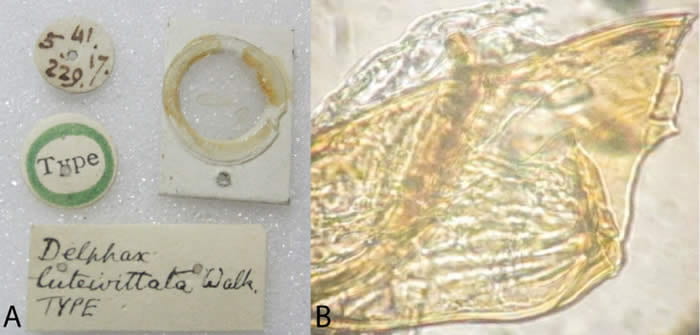[Back to Higher classification of Delphacidae]
Family Delphacidae Leach, 1815
Subfamily Delphacinae Leach, 1815
Tribe Delphacini Leach, 1815
Genus Spartidelphax Bartlett and Webb, 2014: 22.
Distribution: East coast North America and the nearby Caribbean
Type species: Delphacodes penedetecta Beamer, 1950: 70.
Recognized Species
There are 3 species in this genus as follows (All moved from Delphacodes s.l. by Bartlett & Webb 2014):
Spartidelphax detectus (Van Duzee, 1897), comb. by Bartlett & Webb, 2014: 25. – USA: CT, DE, FL, GA, LA, MA, MD, ME, MS, NC, NJ, NY, RI, SC, TX, VA, VT; CAN: NS, PE, QC; Anguilla, Bahamas (Exuma, Berry, Eleuthera); Bermuda, British Virgin Islands (Guana, St. Thomas), Jamaica, Mexico, Puerto Rico (inc. Vieques Is.), Turks & Caicos (Bartlett et al. 2014).
= Liburnia detecta Van Duzee, 1897: 248.
= Liburnia circumcincta Van Duzee, 1909: 203-204.
= Megamelus vanduzeei Crawford, 1914: 607, 622.
= Megamelus circumcinctus (Van Duzee, 1909); comb. by Crawford 1914: 629.
= Liburnia vanduzeei (Crawford, 1914); comb. by Van Duzee 1916: 84.
= Liburnia circumcincta Van Duzee, 1909; syn. by Van Duzee 1917: 777.
= Delphacodes detecta (Van Duzee, 1897); comb. by Muir and Giffard 1924: 26.
= Megamelus vanduzeei Crawford, 1914; syn. by Muir and Giffard 1924: 26.
= Delphacodes vanduzeei (Crawford, 1914); comb. by Osborn 1938: 338; Moore 1950a:
257; 1950b: 32.
Spartidelphax penedetectus (Beamer, 1950), comb. by Bartlett & Webb, 2014: 23. – USA: AL, FL, LA, MS, NC, NJ, TX
= Delphacodes penedetecta Beamer, 1950: 70.
Spartidelphax luteivittus (Walker, 1851), comb. by Bartlett & Webb, 2014: 32. – USA: FL (nomen dubium)
Figures 6, 7
= Delphax luteivitta Walker, 1851: 354.
= Dicranotropis (?) luteivitta (Walker, 1851); comb. by Van Duzee 1916: 84.
= Stenocranus luteivitta (Walker, 1851); comb. by Muir and Giffard 1924: 12; to incertae
sedis by Beamer (1946: 1).
= Delphacodes luteivitta (Walker, 1851); comb. by Bartlett 2010: 472.
Note – As described in Bartlett & Webb (2014), the type specimen of ‘Delphax luteivitta‘ is in poor condition and it could not be determined whether the species was the same as either of the described species (and therefore is the senior name to either of the other species), or represents a different biological entity.
Economic Importance: Limited.
Plant associations:
Spartidelphax detectus – Spartina patens (Aiton) Muhl. (Poaceae, saltmeadow cordgrass), Spartina alterniflora Loisel. (smooth cordgrass) (Denno 1977, 1978), with S. alterniflora “…an inferior host plant for development” (Denno 1977: 366). Distichlis spicata (L.) Greene (saltgrass, Poaceae) was reported on specimen labels. (S. detectus is probably Spartina patens specialist with the other reported host associations accidental)
Spartidelphax penedetectus – Spartina alterniflora Loisel. (smooth cordgrass) (Wilson et al. 1994, Ferrenberg & Denno 2003).
Plant names from USDA PLANTS; plant associations from Denno 1977, Wilson 2012, Bartlett & Webb 2014.
Recognition
Key to species of Spartidelphax (males) (From Bartlett and Webb 2014).
1. Aedeagus with teeth as ventral serrulations; vertex nearly 1.5x longer than wide; body length (brachypterous male) 2.18-2.57 mm … Spartidelphax penedetectus
1’. Aedeagus with long rows of lateral teeth extending beyond the distal third of aedeagus; vertex usually 1.3x longer than wide; body length (brachypterous male) 1.89-2.43 mm …. Spartidelphax detectus
Spartidelphax detectus (Allotype, female), Photos by Kimberley Shropshire (UD Department of Entomology and Wildlife Ecology)
Spartidelphax detectus (male), Photos by Kimberley Shropshire (UD Department of Entomology and Wildlife Ecology)
Spartidelphax penedetectus Photos by Kimberley Shropshire (UD Department of Entomology and Wildlife Ecology) (Pygofer is from paratype)
Type specimen of Delphax luteivitta Walker (Photos by Mick Webb, British Museum Natural History)
Websites:
EOL
BOLD. (genus not explicitly listed, link to subgamily)
FLOW.
Discover Life
Bugguide.
Kunzweb gallery (Costa Rica; Europe). (links to family or subfamily; genus not listed)
3I Interactive Keys and Taxonomic Databases (Dmitry Dmitriev)
Hemipterans of North Carolina http://www.dpr.ncparks.gov/bugs/index.php
Molecular resources:
BOLD does not explicitly list Spartidelphax at this time (19 Sept. 2017); however, data is available for Delphacodes detecta and D. penedetecta; at least as identified; Genbank also has some data for D. detecta and D. penedetecta.
Selected references (abridged from Bartlett & Webb, 2014)
Bartlett, C. R. (2010 dated 2009). Diversity in New World stenocranine planthoppers (Hemiptera: Delphacidae). Transactions of the American Entomological Society 135: 443-486.
Bartlett C. R. and M. D. Webb. 2014. The planthopper genus Spartidelphax, a new segregate of Nearctic Delphacodes (Hemiptera, Delphacidae). ZooKeys 453: 19-36. (also here)
Bartlett, C. R., L. B. O’Brien and S. W. Wilson. 2014. A review of the planthoppers (Hemiptera: Fulgoroidea) of the United States. Memoirs of the American Entomological Society 50: 1-287.
Beamer R. H. 1946. The genus Stenocranus in America North of Mexico (Homoptera: Fulgoridae). Journal of the Kansas Entomological Society 19: 1-11.
Beamer, R. H. 1950. Delphacodes detecta (Van D.) and a new closely related species (Homoptera: Fulgoridae: Delphacinae). Journal of the Kansas Entomological Society 23(2): 68-71.
Bourgoin, T. 2014. FLOW (Fulgoromorpha Lists on The Web): a world knowledge base dedicated to Fulgoromorpha. Version 8, updated May 27, 2014. http://hemiptera-databases.org/flow/. (Spartidelphax here)
Britton, W. E. 1923a. Guide to the insects of Connecticut. Part IV. The Hemiptera or sucking insects of Connecticut. Bulletin. State of Connecticut. State Geological and Natural History Survey 34:1-807. (p. 54 here)
Crawford, D. L. 1914. A contribution toward a monograph of the homopterous insects of the family Delphacidae of North and South America. Proceedings of the United States National Museum 46: 557-640. (p. 615, error syn.)
Davis, L. V. and I. E. Gray. 1966. Zonal and seasonal distribution of insects in North Carolina salt marshes. Ecological Monographs 36: 275-295.
Denno, R .F. 1975. Wing polymorphism in salt marsh inhabiting Fulgoroidea. Journal of New York Entomological Society 83: 253-254.
Denno, R. F. 1976. Ecological significance of wing polymorphism in Fulgoroidea which inhabit tidal salt marshes. Ecological Entomology 1: 257-266.
Denno, R. F. 1977. Comparison of the assemblages of sap-feeding insects (Homoptera-Hemiptera) inhabiting two structurally different salt marsh grasses in the genus Spartina. Environmental Entomology 6: 359-372.
Denno, R. F. 1978. The optimum population strategy for planthoppers (Homoptera: Delphacidae) in stable marsh habitats. Canadian Entomologist 110: 135-142.
Denno, R. F. 1980. Ecotope differentiation in a guild of sap-feeding insects on the salt marsh grass, Spartina patens. Ecology 61: 702-714.
Ferrenberg, S. M. and R. F. Denno. 2003. Competition as a factor underlying the abundance of an uncommon phytophagous insect, the salt-marsh planthopper Delphacodes penedetecta. Ecological Entomology 28: 58-66.
Kennedy A. C., C. R. Bartlett and S. W. Wilson. 2012. An annotated checklist of the delphacid planthoppers (Hemiptera: Delphacidae) of Florida with the description of three new species and the new genus, Meristopsis. Florida Entomologist 95(2): 395-421.
Leach, W. E. 1815a. Entomology. The Edinburg encyclopedia; conducted by David Brewster 9: 57-172. (family Delphacidae here).
Metcalf, Z. P. 1923. A key to the Fulgoridae of eastern North America with descriptions of new species. Journal of the Elisha Mitchell Scientific Society 38: 139-230, plus 32 plates. (several references to Liburnia detecta, e.g., Key p. 173)
Metcalf, Z. P. 1938a. The Fulgorina of Barro Colorado and other parts of Panama. Bulletin of the Museum of Comparative Zoology, Harvard College 82: 277-423. [Delphacodes detecta noted]
Metcalf, Z. P. 1943. General Catalogue of the Hemiptera. Fascicle IV, Fulgoroidea, Part 3, Araeopidae (Delphacidae). Smith College, Northhampton, Massachusetts. (D. detecta on p. 425).
Metcalf, Z. P. and H. Osborn. 1920a. Some observations on insects of the between tide zone of the North Carolina coast. Annals of the Entomological Society of America. 13:108-117.
Moore, G. A. 1950a. Catalogus des hémiptères de la province de Québec. Le Naturaliste Canadien 77: 233-271.
Moore, G. A. 1950b. Check-list of Hemiptera of the province of Quebec. Contributions de l’Institut de Biologie de l’Université de Montréal 26: 1-49.
Muir, F.A.G. and W. M. Giffard. 1924. Studies in North American Delphacidae. Bulletin of the Experiment Station of the Hawaiian Sugar Planters’ Association, Entomological series no. 15: 1-53.
Oman, P. W. 1947. The types of Auchenorrhynchous Homoptera in the Iowa State College Collection. Iowa State College Journal of Science 21: 161-228.
Osborn, H. 1938. The Fulgoroidea of Ohio. Bulletin of the Ohio Biological Survey 6: 283-349.
Raupp, M. J. and R. F. Denno. 1979. The influence of patch size on a guild of sap-feeding insects that inhabit the salt marsh grass Spartina patens. Environmental Entomology 8: 412-417.
Rey, J. R. 1981. Ecological biogeography of arthropods on Spartina islands in northwest Florida. Ecological Monographs 51: 237-265.
Smith, J. B. 1910a. Order Homoptera. Pp. 87-130. In: A report of the insects of New Jersey. Annual Report of the New Jersey State Museum 1909:1-888. (see p. 97)
Urban, J. M., C. R. Bartlett and J. R. Cryan. 2010. Evolution of Delphacidae (Hemiptera: Fulgoroidea): combined-evidence phylogenetics reveals importance of grass host shifts. Systematic Entomology 35: 678-691.
USDA, NRCS. 2014. The PLANTS Database. National Plant Data Center, Baton Rouge, LA 70874-4490 USA (accessed 28 May 2014). http://plants.usda.gov.
Van Duzee, E. P. 1897. A preliminary review of the North American Delphacidae. Bulletin of the Buffalo Society of Natural Sciences 5: 225-261. (see p. 248)
Van Duzee, E. P. 1909. Observation of some Hemiptera taken in Florida in the spring of 1908. Bulletin of the Buffalo Society of Natural Sciences 9: 149-230.
Van Duzee, E. P. 1912a. Hemipterological gleanings. Bulletin of the Buffalo Society of Natural Science 10: 477-512. (see p. 506)
Van Duzee, E. P. 1916. Check list of Hemiptera (excepting the Aphididae, Aleurodidae and Coccidae) of America north of Mexico. New York Entomological Society, New York, 111 pp.
Van Duzee, E. P. 1917. Catalogue of the Hemiptera of America north of Mexico (excepting the Aphididae, Coccidae and Aleurodidae). University of California Publications, Technical Bulletins, vol. 2. University of California Press, Berkeley, i-xiv, 1-902. (see p. 777)
Walker, F. 1851. List of the specimens of Homopterous Insects in the collection of the British Museum. British Museum, London. Volume 2: 261-636.
Wilson, S. W. 2012. Tymbal morphology and co-occurrence of Spartina sap-feeding insects (Hemiptera: Auchenorrhyncha). Great Lakes Entomologist 45(3-4): 166-184.
Wilson, S. W., C. Mitter, R. F. Denno and M. R. Wilson. 1994. Evolutionary patterns of host plant use by delphacid planthoppers and their relatives. Pp. 7-45 plus appendix. In: Denno, R. F., Perfect, T. J. (Eds.). Planthoppers: Their Ecology and Management. Chapman and Hall, New York.

